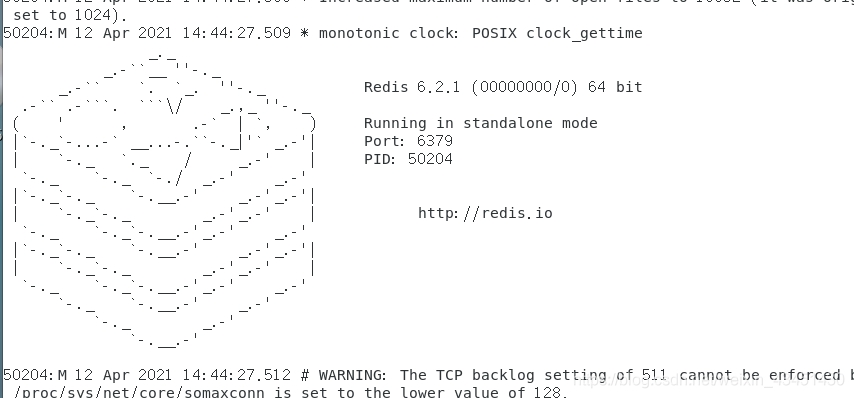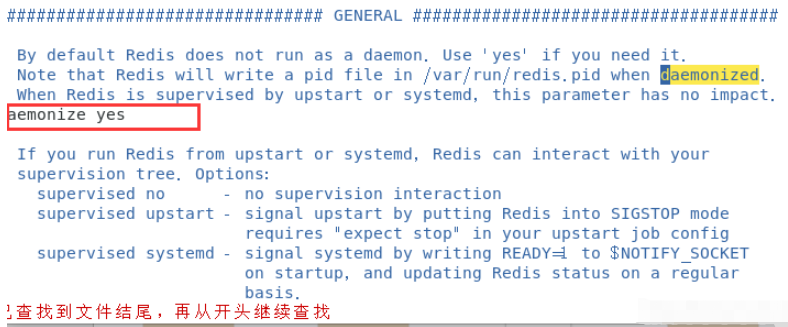//安装c++yum install gcc-c++ -y//查看版本gcc -v
cd redis-6.2.1make
make install
make install PREFIX=/usr/local/redis//后面的是你想要安装的路径
cd /cd usr/local/bin./redis-server
./redis-server redis.conf
ps aux|grep redis
How to install and configure Redis in Centos7
Centos7 install Redis
0, update the file
yum update -y
1, download redis

cd export/install
tar -zxvf redis-6.2.1.tar.gz
Copy after login
3. Installation environment c cd export/install tar -zxvf redis-6.2.1.tar.gz
//安装c++yum install gcc-c++ -y//查看版本gcc -v
Copy after login
//安装c++yum install gcc-c++ -y//查看版本gcc -v

cd redis-6.2.1make
Copy after login
5. Installation serviceThis is the default installationcd redis-6.2.1make
make install
Copy after login
This is a custom installationmake install
make install PREFIX=/usr/local/redis//后面的是你想要安装的路径
Copy after login
I am the default installation. make install PREFIX=/usr/local/redis//后面的是你想要安装的路径

cd /cd usr/local/bin./redis-server
Copy after login
The startup is successful as shown below. cd /cd usr/local/bin./redis-server

cd /cd export/install/redis-6.2.1cp redis.conf /usr/local/bin/
cd /cd usr/local/bin
vim redis.conf
Copy after login
Here is the modification to run in the background. After opening the file,If you want to search, directly enter / in the field you want to search for such as /daemonized and press Enter to search,Press n to indicate the next match The characters :cd /cd usr/local/bin vim redis.conf

./redis-server redis.conf
Copy after login
7.3. Check whether the process is started./redis-server redis.conf
ps aux|grep redis
Copy after login
ps aux|grep redis
 ##8. Close the service
##8. Close the service
./redis-cli shutdown
9. Simply use redis
to open the redis service.:
Open the redis client.
#Test:It is correct that pong appears.
 Exit
Exit
./redis-server redis.conf ./redis-cli
10. Start remote connection Firewall allows.
Firewall allows.
quit
Modify the redis.conf configuration file
Turn off the protected-mode mode,At this time, the external network can directly access
firewall-cmd --zone=public --add-port=6379/tcp --permanent firewall-cmd --reload
This is the format display for setting the password.
Remember to restart the service after modifying it.
修改redis.conf 文件,protected-mode 要设置成no。//如果需要设置密码requirepass 空格后面跟设置的密码修改redis.conf 文件,将 bind 127.0.0.1 修改成bind * -::* 或者直接将bind这一行注释掉
Link redis with other ip addresses The ip here is changed according to the ip address you want to link to
The ip here is changed according to the ip address you want to link to
redis-cli -h 127.0.0.1 -p 6379 shutdown # 干掉redis服务器(比较暴力,谨慎使用) sudo kill -9 pid 进程号
Remote link with password
./redis-cli -h 192.168.10.20 -p 6379
The above is the detailed content of How to install and configure Redis in Centos7. For more information, please follow other related articles on the PHP Chinese website!

Hot AI Tools

Undresser.AI Undress
AI-powered app for creating realistic nude photos

AI Clothes Remover
Online AI tool for removing clothes from photos.

Undress AI Tool
Undress images for free

Clothoff.io
AI clothes remover

AI Hentai Generator
Generate AI Hentai for free.

Hot Article

Hot Tools

Notepad++7.3.1
Easy-to-use and free code editor

SublimeText3 Chinese version
Chinese version, very easy to use

Zend Studio 13.0.1
Powerful PHP integrated development environment

Dreamweaver CS6
Visual web development tools

SublimeText3 Mac version
God-level code editing software (SublimeText3)

Hot Topics
 1386
1386
 52
52
 How to optimize CentOS HDFS configuration
Apr 14, 2025 pm 07:15 PM
How to optimize CentOS HDFS configuration
Apr 14, 2025 pm 07:15 PM
Improve HDFS performance on CentOS: A comprehensive optimization guide to optimize HDFS (Hadoop distributed file system) on CentOS requires comprehensive consideration of hardware, system configuration and network settings. This article provides a series of optimization strategies to help you improve HDFS performance. 1. Hardware upgrade and selection resource expansion: Increase the CPU, memory and storage capacity of the server as much as possible. High-performance hardware: adopts high-performance network cards and switches to improve network throughput. 2. System configuration fine-tuning kernel parameter adjustment: Modify /etc/sysctl.conf file to optimize kernel parameters such as TCP connection number, file handle number and memory management. For example, adjust TCP connection status and buffer size
 Centos stops maintenance 2024
Apr 14, 2025 pm 08:39 PM
Centos stops maintenance 2024
Apr 14, 2025 pm 08:39 PM
CentOS will be shut down in 2024 because its upstream distribution, RHEL 8, has been shut down. This shutdown will affect the CentOS 8 system, preventing it from continuing to receive updates. Users should plan for migration, and recommended options include CentOS Stream, AlmaLinux, and Rocky Linux to keep the system safe and stable.
 Centos shutdown command line
Apr 14, 2025 pm 09:12 PM
Centos shutdown command line
Apr 14, 2025 pm 09:12 PM
The CentOS shutdown command is shutdown, and the syntax is shutdown [Options] Time [Information]. Options include: -h Stop the system immediately; -P Turn off the power after shutdown; -r restart; -t Waiting time. Times can be specified as immediate (now), minutes ( minutes), or a specific time (hh:mm). Added information can be displayed in system messages.
 How to check CentOS HDFS configuration
Apr 14, 2025 pm 07:21 PM
How to check CentOS HDFS configuration
Apr 14, 2025 pm 07:21 PM
Complete Guide to Checking HDFS Configuration in CentOS Systems This article will guide you how to effectively check the configuration and running status of HDFS on CentOS systems. The following steps will help you fully understand the setup and operation of HDFS. Verify Hadoop environment variable: First, make sure the Hadoop environment variable is set correctly. In the terminal, execute the following command to verify that Hadoop is installed and configured correctly: hadoopversion Check HDFS configuration file: The core configuration file of HDFS is located in the /etc/hadoop/conf/ directory, where core-site.xml and hdfs-site.xml are crucial. use
 Difference between centos and ubuntu
Apr 14, 2025 pm 09:09 PM
Difference between centos and ubuntu
Apr 14, 2025 pm 09:09 PM
The key differences between CentOS and Ubuntu are: origin (CentOS originates from Red Hat, for enterprises; Ubuntu originates from Debian, for individuals), package management (CentOS uses yum, focusing on stability; Ubuntu uses apt, for high update frequency), support cycle (CentOS provides 10 years of support, Ubuntu provides 5 years of LTS support), community support (CentOS focuses on stability, Ubuntu provides a wide range of tutorials and documents), uses (CentOS is biased towards servers, Ubuntu is suitable for servers and desktops), other differences include installation simplicity (CentOS is thin)
 Tips for using HDFS file system on CentOS
Apr 14, 2025 pm 07:30 PM
Tips for using HDFS file system on CentOS
Apr 14, 2025 pm 07:30 PM
The Installation, Configuration and Optimization Guide for HDFS File System under CentOS System This article will guide you how to install, configure and optimize Hadoop Distributed File System (HDFS) on CentOS System. HDFS installation and configuration Java environment installation: First, make sure that the appropriate Java environment is installed. Edit /etc/profile file, add the following, and replace /usr/lib/java-1.8.0/jdk1.8.0_144 with your actual Java installation path: exportJAVA_HOME=/usr/lib/java-1.8.0/jdk1.8.0_144exportPATH=$J
 What is the CentOS MongoDB backup strategy?
Apr 14, 2025 pm 04:51 PM
What is the CentOS MongoDB backup strategy?
Apr 14, 2025 pm 04:51 PM
Detailed explanation of MongoDB efficient backup strategy under CentOS system This article will introduce in detail the various strategies for implementing MongoDB backup on CentOS system to ensure data security and business continuity. We will cover manual backups, timed backups, automated script backups, and backup methods in Docker container environments, and provide best practices for backup file management. Manual backup: Use the mongodump command to perform manual full backup, for example: mongodump-hlocalhost:27017-u username-p password-d database name-o/backup directory This command will export the data and metadata of the specified database to the specified backup directory.
 What are the backup methods for GitLab on CentOS
Apr 14, 2025 pm 05:33 PM
What are the backup methods for GitLab on CentOS
Apr 14, 2025 pm 05:33 PM
Backup and Recovery Policy of GitLab under CentOS System In order to ensure data security and recoverability, GitLab on CentOS provides a variety of backup methods. This article will introduce several common backup methods, configuration parameters and recovery processes in detail to help you establish a complete GitLab backup and recovery strategy. 1. Manual backup Use the gitlab-rakegitlab:backup:create command to execute manual backup. This command backs up key information such as GitLab repository, database, users, user groups, keys, and permissions. The default backup file is stored in the /var/opt/gitlab/backups directory. You can modify /etc/gitlab




